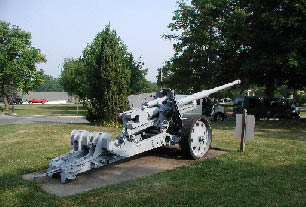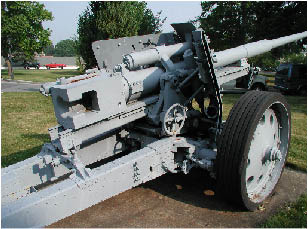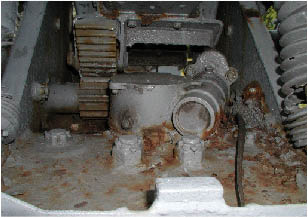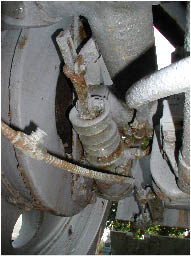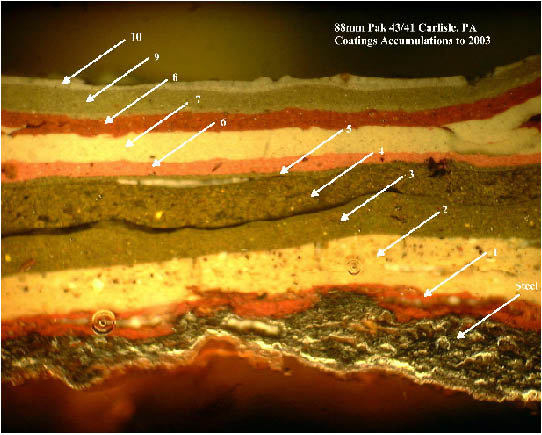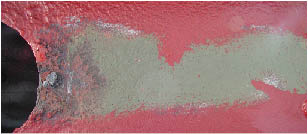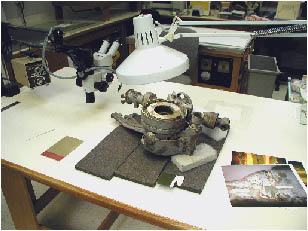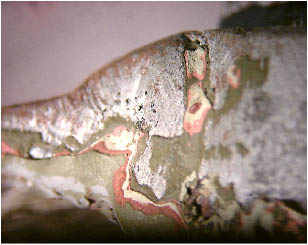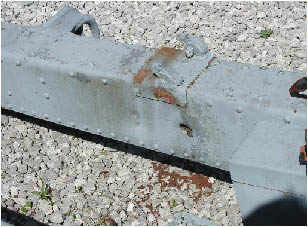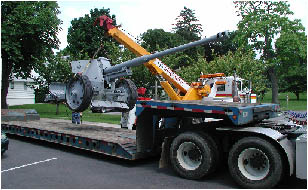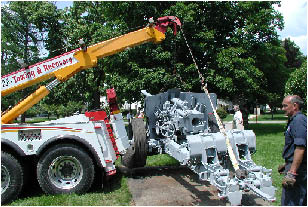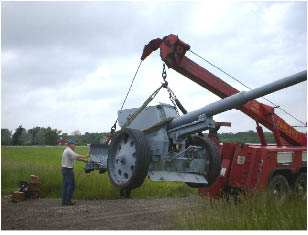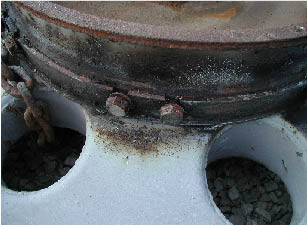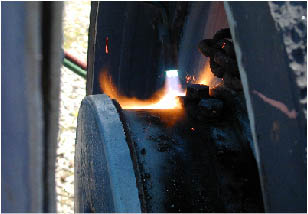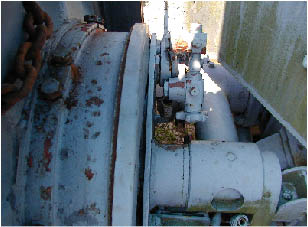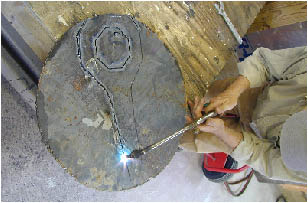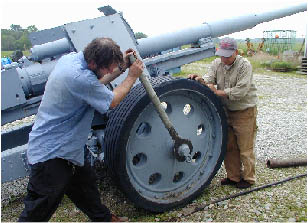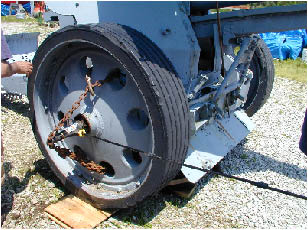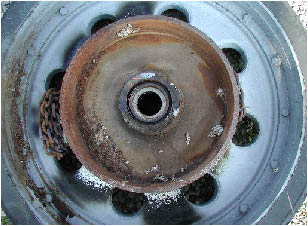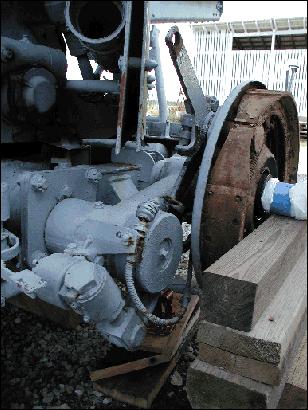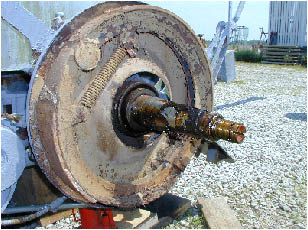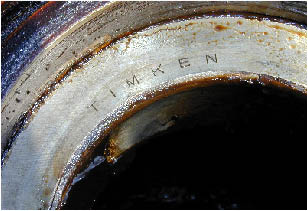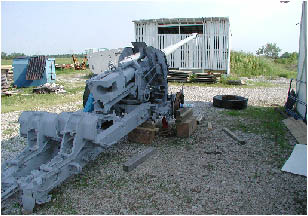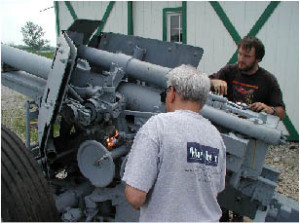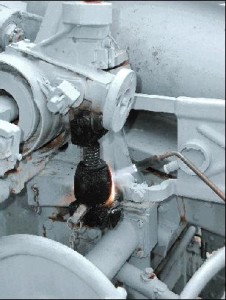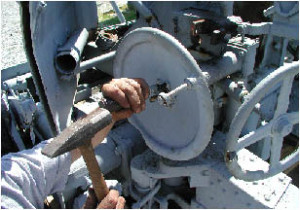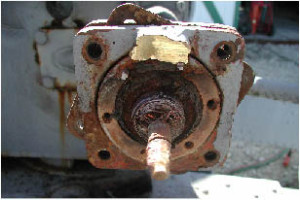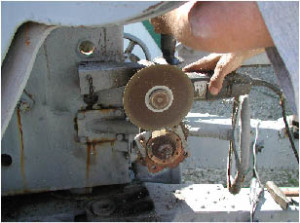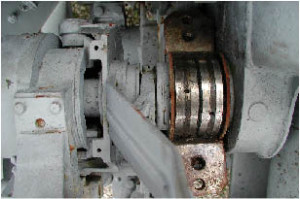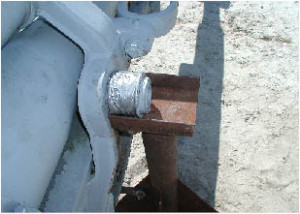1943 German 88mm PAK 43/41 Anti-Tank Gun restored for the U.S. Army Heritage Museum and Education Center in Carlisle Pennsylvania.
Military Artifact Conservation
The restoration work was performed during 2003 by:
Thomas Podnar, Robert Lodge, Curtis McCartney, and Mark Erdmann of
McKay Lodge Conservation Laboratory, Inc.
The German 88mm PAK 43/41 Anti-Tank Gun located for many years at Royal American Circle, Carlisle Barracks, Carlisle, Pennsylvania was examined by Robert Lodge for a response to a Task Order on June 27, 2002. At that time as thorough an examination as possible in the field was made, coating thickness was measured with an electronic gauge, chloride contamination was tested and measured, and dimensional measurements were taken. A proposal was made to the U.S. Army for its restoration and the proposal was accepted. At the time of the condition assessment, it was not known for certain how the artifact came to the United States and be located at the Carlisle Barracks. It was thought that the gun was displayed outdoors there for about 25 years.
Consulted:
- Dr. William Atwater, Curator
U.S. Army Ordnance Museum - Charles Lemonds, Curator
Patton Museum of Calvary and Armor - Patrick Megehee, Curator
U.S.Army Field Artillery Museum - James Whitman,
Collections Manager Canadian War Museum
Identification:
88mm Pak 43/41, Made by Krupp 1943-1945
Two wheeled carriage was common for Russian Front assaults, also used in France and Italy. This 88mm German anti-tank gun is an 8,8 cm (“Acht-Acht”)Panzerabwehrkanone (Pak) 43/41 on the 2-wheeled carriage. The various 88mm weapons have been widely identified in common literature about World War II as the most formidable threat to Allied tanks during WWII. This gun developed from the dual purpose 8,8 cm Fliegabwehrkanone (Flak) gun which itself has a history of development from smaller Flak and Pak guns, each an advance on increasing Allied tank armor
In 1943, Krupp redesigned the 88mm Flak 37 for a gun to be used solely as an anti-tank weapon against Russian tanks. This new gun became known as the Pak 43. While it was still on a cruciform base, the trailer was different from previous versions becoming itself a fixed carriage to permit faster deployment by lowering jacks to support the carriage. The firing mechanism was now electric and the breach was now semi-automatic to eject spent shells and the barrel was fitted with a double baffle muzzle brake. But further improvements in the speed of deployment were needed and in the last design of the “88” by Krupp, it reverted to the older style towable two-wheeled or “split tail” carriage for the “88” becoming the PAK43/41 which is the gun on display at Carlisle Barracks. The split tail carriages were made from existing stock of other guns. The breach block reverted to the sliding horizontal mechanism with a modified semi-automatic gear. Fitted with a large shield the weapon was nicknamed “Scheunetor” or “Barn Door.”
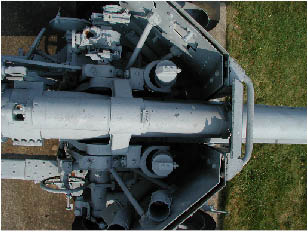
Specifications:
Weight: 4,389 kg (9,655 lbs)
Elevation: -5 to +38 degrees.
Traverse: L28 degrees to R28 degrees
Credit:
The historical information provided briefly above was drawn from the more lengthy historical treatment in:
New Vanguard 46: 88mm Flak 18/36/37/41 & Pak 43 1936-45 (Osprey Publishing). Written by John Norris, iIlustrated by Mike Fuller.
CORROSION:
It was believed that the gun sat outdoors for about 25 years prior to 2002. During the restoration it was discovered that all but a few fragments of original coatings had been removed by abrasive (sand) blasting and the gun had been repainted many times, up to its then current gray coating. In general, there was alot of corrosion. All originally moving parts were immovable; brake drums were firmly corroded to brake pads; sheet metal was eaten away by corrosion.
Details of the condition of the gun before restoration are shown throughout the treatment illustrations below.
CONDITION
ORIGINAL COATINGS:
Coatings analyses were performed in an attempt to determine original color. Excavations with a scalpel and microscopic examination of coatings cross sections revealed small remnants of original color. Cross sections of these small remnants revealed the full history of coating and recoating.
COATINGS HISTORY:
-
- Gray (outer color before restoration).
- Oliv Grun.
- Brown primer or else Rot Brun.
- Dunkel Gelb (restoration?).
- Pink primer.
(At this point all coatings but for a few remnants were removed by abrasive blasting).
- Oliv Grun (maintenance coat?).
- Second coat of Oliv Grun.
- First Oliv Grun (field coat?).
- Factory Dunkel Gelb.
- Factory red lead primer.
- STEEL.
Coatings Evidence:
During restoration, evidence of previous coatings were discovered as the gun was disassembled.
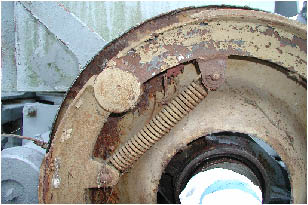
First Image: Original Dunkel Gelb was discovered on the brake shoes and brake back plates when the wheels were removed. The yellow appears quite dull from dirt and age. These areas were also full of sand from a past sand blasting that removed all the earlier coatings but for a few small remnants.
Second Image: Found under one of the carriage tails: Original Olive Grun (Layer #3 in cross-section) or else the later Oliv Grun (Layer #9).
This is the underside of the gun cradle or turret. Later Oliv Grun (Layer No. 9) over a Dunkle Gelb (Layer No. 7) over Rot Brun or a red primer (Layer No. 8). As told in the cross section on the previous page, these coatings were applied to the gun in the past after all earlier coatings were removed by sand blasting. That they are under gun cradle tells that the gun was disassembled to some extent for recoating. This work may have been a restoration after the gun was out of service. If a restoration, it followed the original sequence of colors: red primer, yellow, green.
Removed parts of the gun having remnants of old coatings were taken into the lab for study under a binocular microscope.A remnant of old coatings on the (removed) sighting component was found to retain these layers:
- No. 9. Oliv Grun.
- No. 8. Brown primer or else Rot Brun.
- No. 7. Dunkel Gelb (restoration?).
- No. 6. Pink primer.
- No. 5. Oliv Grun (maintenance coat?).
Note the later Oliv Grun (No. 9) applied after the abrasive blasting matches the last of the early Oliv Grun coatings (No. 5).
The coating used for the current restoration repainting was custom pigmented in our shop to match layer #5 which is seen as the lowest level green in the bottom image on the right. This is the earliest remnant of a German application of color providing a large enough sample for color matching.
Note the later Oliv Grun (No. 9) applied after the abrasive blasting matches the last of the early Oliv Grun coatings (No. 5).
Evidence of Aircraft Attack:
The gun was riddled with projectile holes by Allied aircraft attack from the rear. No projectiles, however, were found in the enclosed spaces of the gun.
TREATMENT
Transport to Oberlin:
It was found convenient to use a truck recovery vehicle to lift and move the 10,000 pound gun. The gun was transported from Carlisle, Pennsylvania to Oberlin, Ohio on a trailer by Keene Transport of Carlisle.
The gun offloaded and heading up the long road to the metal shops of McKay Lodge Conservation laboratory, Inc:
Brake Drum Removal Attempt:
Initial attempts to pull the wheels failed because the brake drums were corroded to the brake pads due to standing water in the drums.
An attempt was then made to seperate the steel wheels from their drums by loosening the bolts that held the drums to the wheels. Despite long heating with an acetylene torch seen in these images, the bolts could not be extracted.
Throughout the disassembly for restoration it was necessary to loosen corroded bolts. The method of repeatedly heating to a red glow followed by chilling with water and then applications of a penetrant was found to be effective.
Removal of the wheels and brake drums revealed that water and blasting sand standing in the bottom of the drum had caused considerable corrosion. Even after removal of this corrosion, the brake shoes were too tight to get the drums back on so an adjustment in the shoes of each wheel was made to create a gap between brake and drum. It was noted that the leading edge of each brake shoe was chamfered to prevent squeal when the brakes were applied. Silence was critical for undetected transport.
Note in the image at the bottom that the axles are at the ends of arms attached to a torsion bar. Note also the large adjustment nut to equalize or level the axles on the torsion bar.
The wheel spindles were found to be well greased, although the grease had hardened somewhat.
The wheel bearings, made by Timken in France, were in good condition.
Detach Sighting Assembly:
The sighting mechanism was removed in advance of removing the barrel.
Below: An attachment to the carriage had a release pin attached to a chain. This was very tightly held by corrosion. As in all loosening of corroded joins during this restoration, breaking free of the corrosion was effected by repeated heatings with an acetylene torch to a red glow followed immediately by chilling with cold water and application of a penetrant.
The left hand elevation control wheel was removed. It had been brazed in place at the top of its join to its hub for some reason and this braze was cut to detach the wheel. The electromagnetic coil within the hub was found to be bound by corrosion of the magnets and steel.
Remove Barrel:
The barrel was removed by taking its retaining plates off its pivot cradles. The forward weight of the barrel rested on two balancing cylinders. These did not extend after removal of the weight upon them because they were corroded.
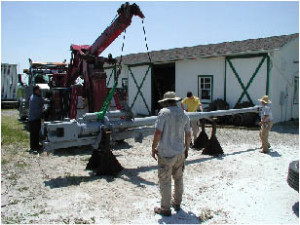
The barrel was placed on steel stands in a way that gave access to all painted surfaces.
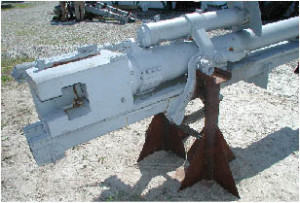
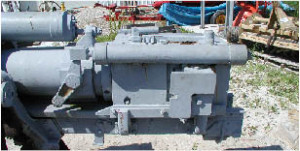
Some Breech Details:
Restoration a the 1943 German 88mm PAK 43/41 Anti-Tank Gun Con’t

